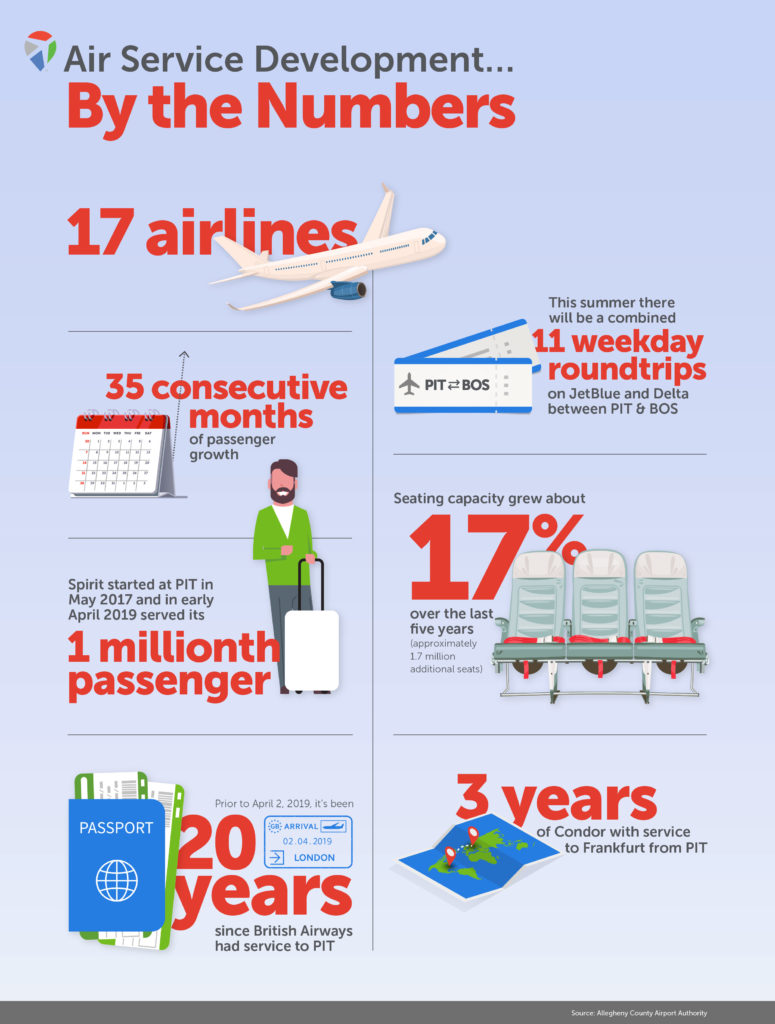PIT’s Winning Streak Hits 35
Consecutive monthly gains in passenger traffic longest since 1986
By Bob Kerlik
Published May 6, 2019
Read Time: 2 mins
It’s official. Pittsburgh International Airport has now gone 35 consecutive months with gains in passenger traffic – a winning streak not seen since 1986.
That’s good news, but why now? And why not during the go-go ‘90s, the height of the US Air hub at PIT?
The answer, at least in part, may be similar to the counsel you get from your financial advisor: Diversify.
“(Pittsburgh) has not put all of its eggs in one basket,” said Bijan Vasigh, a professor of air transport economics and finance at Embry-Riddle Aeronautical University in Daytona Beach, Fla.
Vasigh credits the rise to a number of factors: the growing diversity of carriers (particularly low-cost carriers), more nonstop routes and the overall momentum of the national economy.
“If the economy is improving and if people have more money, they will travel more. Many airports are seeing good growth,” Vasigh said. “The management of Pittsburgh has been doing very well, including bringing low-cost airlines in to fill the void. They have been able to take advantage of the situation.”
Vasigh noted that low-cost carriers like Spirit and Allegiant can bring net new passengers to the airport, when people decide to take a trip based on low-priced airfare.
Numbers through March show PIT experienced 35 consecutive months of monthly year-over-year passenger growth, meaning March 2019’s 837,561 passengers topped March 2018’s 824,647 passengers and so on. The last streak that long ended in 1986 after 44 months of growth.
The airport finished 2018 with 9.7 million passengers, the most since 2007.
Southwest carries the largest share of Pittsburgh’s passengers at 26.7 percent, followed by American (23.7 percent), Delta (17.9 percent), United (15 percent), Spirit (7.2 percent) and Allegiant (3.3 percent), among others.
“I think this trend demonstrates that the market has been underserved for quite some time and that we’ve been able as the airport and regional community to provide the right type of air service that the market has demanded,” said Bryan Dietz, vice president of air service development.
Dietz said diversification of carriers means that if one airline drops a route, others may step in to serve the demand on that route. Delta and JetBlue, for example, have increased flights to Boston as American pulled back. Now, Pittsburgh has more flights to Boston, 11 times a day, than at any point in its history.
That’s a function of serving the Pittsburgh market’s needs, not connecting passengers from other places. The airport isn’t dependent on a single carrier for success, he said.
“The sweet spot that we’ve been able to hit is being able to take a look at what the market needs are and match those up with the strategy of airlines looking to expand,” Dietz said.
Watch
This Next
Read
This Next






